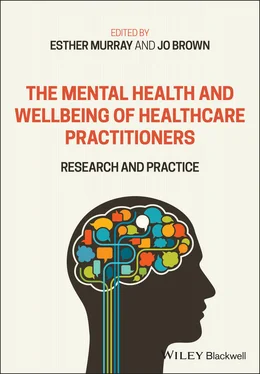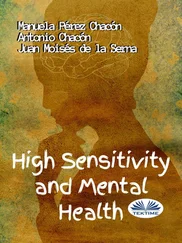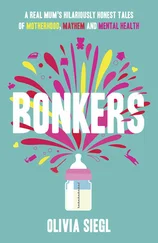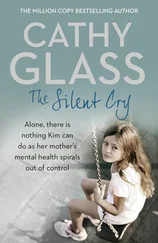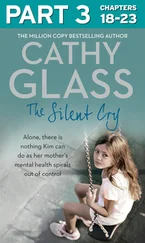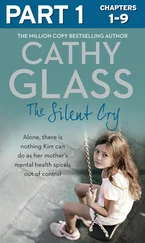The Mental Health and Wellbeing of Healthcare Practitioners
Здесь есть возможность читать онлайн «The Mental Health and Wellbeing of Healthcare Practitioners» — ознакомительный отрывок электронной книги совершенно бесплатно, а после прочтения отрывка купить полную версию. В некоторых случаях можно слушать аудио, скачать через торрент в формате fb2 и присутствует краткое содержание. Жанр: unrecognised, на английском языке. Описание произведения, (предисловие) а так же отзывы посетителей доступны на портале библиотеки ЛибКат.
- Название:The Mental Health and Wellbeing of Healthcare Practitioners
- Автор:
- Жанр:
- Год:неизвестен
- ISBN:нет данных
- Рейтинг книги:3 / 5. Голосов: 1
-
Избранное:Добавить в избранное
- Отзывы:
-
Ваша оценка:
- 60
- 1
- 2
- 3
- 4
- 5
The Mental Health and Wellbeing of Healthcare Practitioners: краткое содержание, описание и аннотация
Предлагаем к чтению аннотацию, описание, краткое содержание или предисловие (зависит от того, что написал сам автор книги «The Mental Health and Wellbeing of Healthcare Practitioners»). Если вы не нашли необходимую информацию о книге — напишите в комментариях, мы постараемся отыскать её.
Explore this innovative new volume covering the growing mental health crisis amongst healthcare practitioners The Mental Health and Wellbeing of Healthcare Practitioners
The Mental Health and Wellbeing of Healthcare Practitioners
The Mental Health and Wellbeing of Healthcare Practitioners — читать онлайн ознакомительный отрывок
Ниже представлен текст книги, разбитый по страницам. Система сохранения места последней прочитанной страницы, позволяет с удобством читать онлайн бесплатно книгу «The Mental Health and Wellbeing of Healthcare Practitioners», без необходимости каждый раз заново искать на чём Вы остановились. Поставьте закладку, и сможете в любой момент перейти на страницу, на которой закончили чтение.
Интервал:
Закладка:
It is true that what is needed is both structural change, team training and a focus on individual support and wellbeing. The chapters in this book focus on the ways in which staff experiences can be understood, in order to inform intervention; and the ways in which individuals have come together to create grassroots change.
CHAPTER 1 Borrowed Words in Emergency Medicine: How ‘Moral Injury’ Makes Space for Talking
Esther Murray
Barts and The London School of Medicine and Dentistry, Queen Mary University of London, London, UK
CONTEXT
In 2015 I started working at a medical school, it was an important move for me as I wanted to be a part of how doctors were trained, not only to ensure patients get the best possible care but also to understand how we can support doctors in practicing their profession without being harmed by it. I hadn't taken up a research post, but I had come along with a research idea, I wanted to know how it was that doctors (at this stage of my thinking) could practice for years, see terrible and upsetting things daily and not be affected by it. I had carried out some literature searches and found concepts like compassion fatigue and burnout, I had read reports of post‐traumatic stress disorder in emergency responders, but what I had not seen was a systematic approach to understanding what was happening to doctors, and how we could combat it.
In my searches of ‘doctor’ and ‘psychological’ and ‘trauma’ I finally came across the writings of Jonathan Shay, a psychiatrist in the United States working with American war veterans in a VA hospital, this is a facility provided by the Veterans Health Association and serves veterans across the United States. His explanation of moral injury as one of the types of psychosocial harms that could be caused by repeated exposure to different types of traumatic events resonated powerfully with me. Although it did not seem to me that lots of doctors were suffering from diagnosable mental illness, it did seem that something was amiss. I could not really understand how it was that doctors were trained into, and then went on to practice their profession without the sort of regular supervision that psychologists are required to receive. I read about Balint groups, I heard about Schwartz rounds, but I could not find anything system‐wide or systematic in the United Kingdom. What I did see was widespread discussions of burnout, equally widespread use of alcohol as a coping strategy, and a general sense that there was nothing to do but ‘crack on’. This attitude that if you could not handle the pain then you should not be working in medicine at all was passed down to students and junior doctors.
Once I could pursue my area of interest at the medical school, I wanted to know if moral injury felt like a useful concept to doctors. I started my research with students in pre‐hospital care, which is an area of medicine practiced by a variety of first responders such as doctors, nurses, paramedics, first aiders, remote medicine practitioners, voluntary aid workers, police, fire, and armed forces, it essentially covers any analytic, resuscitative, stabilising or preventative care given before the patient is admitted to hospital both at the scene of the incident and en route. The students I wanted to interview were all involved in either the Pre‐hospital Care Programme ( PCP ) or the Intercalated Degree in Pre‐hospital Medicine. The PCP is a student‐led, staff supported programme in which students go out on shifts with the London Ambulance Service, mentored by specially trained paramedics. Students can join this programme from their second year at medical school. The intercalated degree (iBSc) in Pre‐hospital Medicine is a year‐long degree in the clinical, professional and psychosocial aspects of pre‐hospital medicine for medical students. I was sure that pre‐hospital care must be where the trouble lay since there was more evident trauma there than anywhere, with road traffic accidents, stabbings, shootings and suicide. The kind of medicine performed at the scene, the increasing likelihood of responding to terror attacks, and other kinds of mass casualties all seemed to suggest that pre‐hospital care was where psychological trauma must occur. As time went on, it became clear that I was not quite right about what constitutes a ‘traumatic event’ for a doctor, and that doctors were only a small subsection of the people I should be thinking about, that no one was really thinking much about students and that no one had oversight of the situation or the degree of harm that had already been inflicted on healthcare professionals of all kinds.
Since I started out in 2015 the issue of the mental health of healthcare professionals has become more widely discussed. More and more work is being done at a national and local level to map the extent of the problem and there is recognition of the dearth of solid research that captures the experience of healthcare professionals, especially over time (General Medical Council ( GMC ), [1]). The terms usually used to describe the experience of being affected by healthcare work have often been borrowed from other areas of practice and it is worth tracing their various histories here.
Compassion Fatigue:Sinclair et al.'s [2] review of the use of the term compassion fatigue provides us with a useful frame for considering how we talk about the psychosocial effects of working in healthcare. Compassion fatigue refers to the gradual erosion of compassionate feelings towards, for example, patients, because of the high demands and stressful nature of the job. The point that Sinclair and colleagues are trying to make, though, is that the term ‘compassion fatigue’ like many similar terms in healthcare, is used without due care or appropriate rigour. Ledoux [3] points out that rather than trying to connote a lessening of compassion, as if compassion were a finite resource running in only one direction, it could be worth noting that much of the difficulty in maintaining compassionate attitudes is related to those things which thwart the expression of compassion such as long working hours, too few staff for too many patients, lack of rest for staff or opportunities to offload concerns. This conceptualisation is much closer to that of moral distress which has also been extensively explored in nurses and which is discussed below. Interesting observations can be made about those factors which might explain how they occur, it may be that some caring strategies are simply more prone than others to result in compassion fatigue, for example, a tendency to have a ‘rescuing’ style of caring will result in difficult feelings if the patient cannot be ‘rescued’; a sense that perhaps the patient's illness is in part self‐inflicted will interfere with compassionate feelings; difficult or disrupted patient interactions might mean that satisfaction cannot so easily be gained from the encounter and thus the good feelings which might offset the difficult or depleting feelings cannot necessarily be accessed.
An alternative conceptualisation of compassion fatigue is proposed by Charles Figley in his 1995 book ‘Compassion Fatigue: Coping with Secondary Stress Disorder in Those Who Treat the Traumatised’ in which compassion fatigue is a form of distress which arises from being exposed to the traumatic experiences of others’. The book focuses on the experiences of psychotherapists, trauma counsellors and others in the business of addressing the psychological needs of people who have undergone trauma. The term ‘compassion fatigue’ itself was borrowed from psychotherapists' experiences, as many of the terms used in understanding the emotional experiences of healthcare professionals have been borrowed. References to compassion fatigue as conceptualised by Figley, appear in papers about healthcare workers having been lifted wholesale and without further explanation in the text (see, for example, [4]). This is by no means a strange occurrence, in fact, in healthcare, the borrowing of learning from other industries is commonplace, with probably the most well‐known example being the borrowing of safety and quality assurance techniques such as checklists, and learning on human factors from aviation. The learning from organisational psychology or other systems‐based work, though, reminds us that it is not usually effective to take a concept wholesale from one area and apply it to another. It would be wiser to verify the appropriateness of the concept first. I have often wondered if the scientific background of much of medical practice has done it a disservice, in the end, meaning that concepts from social science do not look so credible as those from the physical sciences and are thus appropriated without much rigour, seeming ‘good enough’ or maybe ‘harmless enough’.
Читать дальшеИнтервал:
Закладка:
Похожие книги на «The Mental Health and Wellbeing of Healthcare Practitioners»
Представляем Вашему вниманию похожие книги на «The Mental Health and Wellbeing of Healthcare Practitioners» списком для выбора. Мы отобрали схожую по названию и смыслу литературу в надежде предоставить читателям больше вариантов отыскать новые, интересные, ещё непрочитанные произведения.
Обсуждение, отзывы о книге «The Mental Health and Wellbeing of Healthcare Practitioners» и просто собственные мнения читателей. Оставьте ваши комментарии, напишите, что Вы думаете о произведении, его смысле или главных героях. Укажите что конкретно понравилось, а что нет, и почему Вы так считаете.
